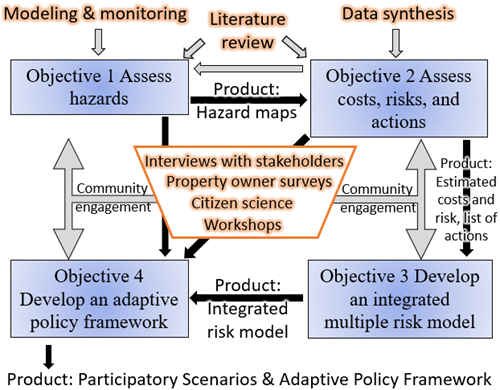

Climate change is increasing vulnerability of Arctic urban communities to natural hazards such as unstable permafrost, wildfire, and rain-in-winter events. These hazards put residents and property at risk and impose economic costs, and households, businesses, and governments must adapt to these interacting hazards. This research is developing detailed maps showing how the occurrence of these three natural hazards has evolved simultaneously in the Municipality of Anchorage and the Fairbanks North Star Borough, Alaska, and Whitehorse, Yukon, Canada over the past several decades, and how they might change over the next 40 years.

Process flow diagram illustrates how the objectives and products relate to each other and integration to better understand how hazards are changing in urban areas, assess the public and private costs, risks, and actions taken to adapt to or mitigate these risks, and evaluate what measures could enhance the capacity of residents and governments to respond effectively as climate continues to change.
This project is one of the first to include effects of climate change on private as well as public infrastructure, a gap which has limited the understanding of effects of climate change in Alaska. Results provide a framework that other Arctic communities can use to assess risks and reduce economic damages due to climate change and provide examples to increase resilience. The research helps partner communities make better-informed decisions regarding how and where to build and manage public and private infrastructure and finance public services. This framework can be used by other Arctic communities to assess risks and reduce economic damages due to climate change.